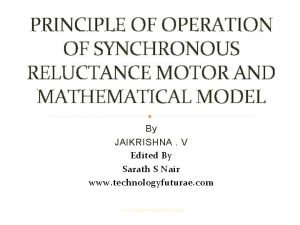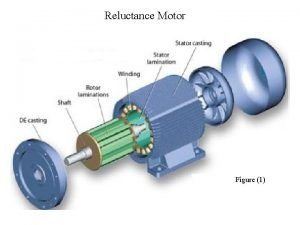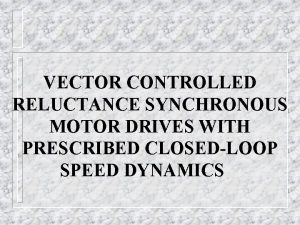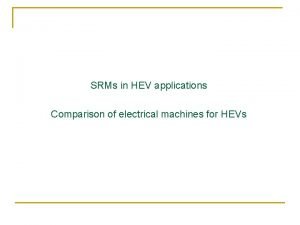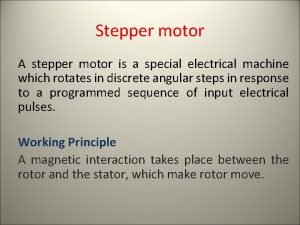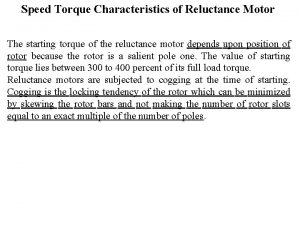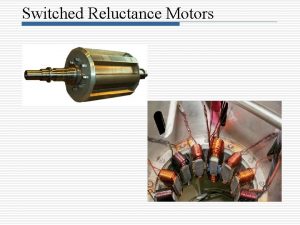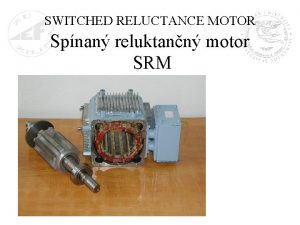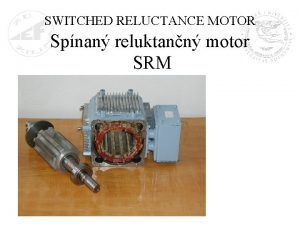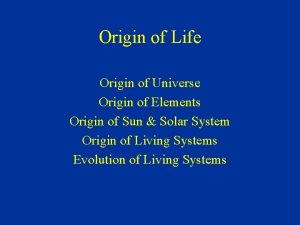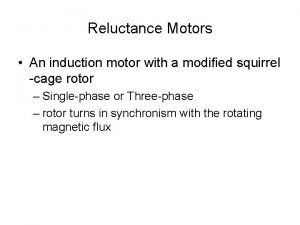Reluctance Motor Figure 1 Reluctance Motor The origin












- Slides: 12

Reluctance Motor Figure (1)

Reluctance Motor The origin of this motor can be traced back to 1842. The Synchronous reluctance motor has a stator wounded as that of a 3 -phase induction machine. It works as a synchronous motor without DC field winding in its rotor. A reluctance motor is a type of electric motor that induces non-permanent magnetic poles on the ferromagnetic rotor. Torque is generated through the phenomenon of magnetic reluctance. Hence, it is not a permanent magnet motor, because its salient rotor is composed of soft ferromagnetic material (of a thin hysteresis loop with high remanence and small coercive force).

Construction of Reluctance Motor Rotor 1 - Notch-Type Rotor • “Notch” areas are of “High -Reluctance” • “Pole” areas are known as “Salient” Poles • Number of salient poles must match the number of stator poles Figure (2)

2 - Flat and Barrier Slot Rotors Figure (4)

Principle of Operation When a piece of magnetic material is free to move in a magnetic field, it will align itself with the magnetic field to minimize the reluctance of the magnetic circuit. To put it another way the piece will orient itself towards the magnetic pole creating the field. The torque on the rotor created in this way is called the reluctance torque. Figure (5)

• Rotor accelerates towards synchronous speed • At a “critical” speed, the low-reluctance paths provided by the salient poles will cause them to “snap” into synchronism with the rotating flux. • When the rotor synchronizes, slip is equal to zero • Rotor pulled around by “reluctance torque” • Figure (6) shows the rotor synchronized at no load. Figure (6)

Figure (7)

N S Rotor radius N Figure (9) S Figure (8)


Types of reluctance motor: There are two types of reluctance motor: 1. Synchronous reluctance motor. 2. Switched reluctance motor, or (Variable reluctance motor).

Single-phase Reluctance Motor Figure (10) Let us discuss how a single-phase reluctance motor works. When the stator of the reluctance motor is supplied with an AC supply as a (single phase), (split-phase) induction motor, the motor starts due to the (induction torque) of the induced eddy current in the rotor short-circuited bars.

Gradually it accelerates and attains speed very close to synchronous speed. The starting/ centrifugal switch disconnects the axillary winding of the motor at a speed of about 75% of the synchronous speed. When the reluctance motor starts to run at a speed close to synchronous speed, a reluctance torque is produced. The rotor aligns itself in minimum reluctance position. The rotor pulls into synchronism. After pulling into synchronism, the induction torque disappears but the rotor remains in synchronism due to synchronous reluctance torque alone. The motor adjusts its torque angle for change in load as in 3 -ph synchronous motor. If load is excessive motor may not pull into synchronism and it may pull out of synchronism. In a 3 -phase reluctance motor the stator winding are the same as that of the induction motor with salient pole rotor as that shown in Fig. (10) above.
 Relucatnce
Relucatnce Single phase reluctance motor
Single phase reluctance motor Switched reluctance motor
Switched reluctance motor Switched reluctance motor
Switched reluctance motor Stepper motor construction and working
Stepper motor construction and working Torque speed characteristics of switched reluctance motor
Torque speed characteristics of switched reluctance motor Torque speed characteristics of switched reluctance motor
Torque speed characteristics of switched reluctance motor Hro principles
Hro principles ưu thế lai là gì
ưu thế lai là gì Hệ hô hấp
Hệ hô hấp Tư thế ngồi viết
Tư thế ngồi viết Cái miệng xinh xinh thế chỉ nói điều hay thôi
Cái miệng xinh xinh thế chỉ nói điều hay thôi Hình ảnh bộ gõ cơ thể búng tay
Hình ảnh bộ gõ cơ thể búng tay
